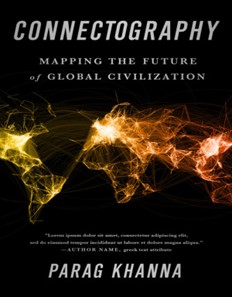Book Review
Posted on : July 11, 2024Author : Dipan Bhattacharjee

Connectography: Mapping the future of global civilization
Author: Parag Khanna
Publisher : Random House (19 April 2016)
Hardcover : 496 pages
ISBN-10 : 9780812988550
ISBN-13 : 978-0812988550
This book is a comprehensive and analytical one focusing on the concept of connectography which is a provocative remapping of the contemporary capitalism, based on planetary mega-infrastructures, inter-continental corridors on connectivity and trans-national supply chains rather than traditional political borders. It gives us a broad view of the connected world. Also, it gives us a glimpse of the future and puts forward the situations which may lead to a third world war. Parag Khanna is an eminent author who was born in Kanpur, India. His childhood was spent between India and the United Arab emirates before his family moved to New York City. He obtained a degree of Bachelor of Science in International Affairs from the School of Foreign Service at Georgetown university, and also a Master of Arts in Security studies from Georgetown in 2005.
The book was penned down in a time when the technological advancements had already reached their topmost points and the whole world had been connected not only by mega infrastructures but also by the mediating tool of Internet. The world had witnessed major political events that year, such as fall of Eastern Aleppo, impeachment of the presidents of Brazil and South Korea, the Trans-pacific partnership flops, Britain voting to step out from the European Union and Russia interfering in the US Presidential Election. Thus, as the world stood amidst such tumultuous situations, it was really a high time that a definitive text would be penned down to unfurl before us a detailed and critical evaluation of the intricately connected and highly complicated world affairs. Hence, we can undoubtedly say that the book by Parag Khanna is really a call of the time.
Going through all the chapters, it was clearly understood that the text presented a vivid outlook on the connected world and bestowed the reader a crystal clear perception of the ever- changing world, now more faster, thanks to the modern infrastructure and advanced technology. It also provides a glimpse of a futuristic world by describing the situations which may give birth to a third world war. Though throughout the book it mainly focused on the ever-advancing technologies within the world, but at the ultimate chapter, it proclaims the superiority of nature over the technological advancements.
The book is divided into sixteen chapters. The first chapter proclaims that the adage of “Geography is destiny” about the world is becoming obsolete. Thanks to global transportation, communications and energy infrastructures – highways, railways, airports, pipelines, electricity grids, Internet cable, and more, the future has a new maxim- Connectivity is destiny”. The rest chapters go on to explain the phenomenon of transformation from globalization to hyper-globalization.
The chapters go on to speak about the prospects of a third world war in a highly interconnected yet multiplayer world in a manner which is strikingly similar to the Orwellian scenario as lucidly portrayed in 1984 where we see three states in a perpetual stalemate ridden conflict with the only difference that unlike a conventional war, here exists an economic tug of war. It goes on to highlight the expansionist tendency of USSR and China. Further says that one thing should be kept in mind, that the expansion of the historical empires were based on manpower, technology, finances and climate. As a matter under connectivity, the further development of railway corridors is taking place, at the transnational levels, which is faster than shipping and cheaper than flying. It gives a brief view about cyber civilizations and its discontents. It argues that the internet, described as a vast, unique experiment in anarchy, embodies the border-neutral ethos of scientific community, challenging traditional notions of identity, community, and governance.
Thus, the book precisely points out all the details of the connected world. Of course, if any researcher wants to traverse the paths of the connected world of geopolitics, then this book is a must read for him or her. However, since it was written in 2016, the pandemic and what it means for a highly connected world is not part of the discussions There have been transformations in the political arena too as a fallout of this shocking catastrophe. Hence, judging today’s world totally through the lens of this book is of course erroneous in nature. We have to keenly observe all the other advancements and other proceedings which had taken place since 2016 and then only we will achieve the accurate measures of the political spheres in the connected world.
Also, it can be mentioned that it has overlooked the human aspect of connectivity. It is the people who are the driving force behind every aspect of human history and likewise connectivity too has it’s foundations in human connecting. While it is true that economic connectivity is the main integrator of a globalizing world, the role of human relations has been somewhat neglected. And also, it has failed to speak about the factor of de- globalization.
However, overall, it is a crucial and relevant text in these turbulent times. Even as connectivity makes the world more unpredictable, but simultaneously it leads to collective resilience.
References:-
1) Acemoglu, Daron, and James Robinson. Why nations Fail: The Origins of power, Prosperity, and Poverty, Crown Business,2013.
2) Acuto, Michele, Building Global Cities, Oxford Programme for the Future of Cities,2013
3) Adler-Nissen, Rebecca, Opting out of the European Union, Cambridge University Press,2015.
Dipan Bhattacharjee
Intern, Asia in Global Affairs
The views, thoughts, and opinions expressed in the text belong solely to the author, in his personal capacity. It does not reflect the policies and perspectives of Asia in Global Affairs.





Leave a Reply